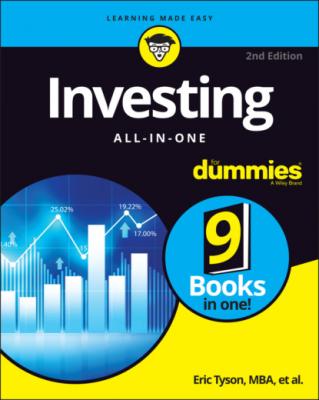Investing All-in-One For Dummies. Eric Tyson
Чтение книги онлайн.
Читать онлайн книгу Investing All-in-One For Dummies - Eric Tyson страница 18
 ideally via mutual funds and exchange-traded funds (see Chapter 1 in Book 5).
ideally via mutual funds and exchange-traded funds (see Chapter 1 in Book 5).
Of course, investing overseas can’t totally protect you in the event of a global economic catastrophe. If you worry about the risk of such a calamity, you should probably also worry about a huge meteor crashing into Earth. Maybe there’s a way to colonize outer space… .
Consider your time horizon
Investors who worry that the stock market may take a dive and take their money down with it need to consider the length of time that they plan to invest. In a one-year period in the stock and bond markets, a wide range of outcomes can occur (as shown in Figure 2-1). History shows that you lose money about once in every three years that you invest in the stock and bond markets. However, stock market investors have made money (sometimes substantial amounts) approximately two-thirds of the time over a one-year period. (Bond investors made money about two-thirds of the time, too, although they made a good deal less on average.)
© John Wiley & Sons, Inc.
FIGURE 2-1: What are the odds of making or losing money in the U.S. markets? In a single year, you win far more often (and bigger) with stocks than with bonds.
Although the stock market is more volatile than the bond market in the short term, stock market investors have earned far better long-term returns than bond investors have. (See the later section “Stock returns” for details.) Why? Because stock investors bear risks that bond investors don’t bear, and they can reasonably expect to be compensated for those risks. Remember, however, that bonds generally outperform a boring old bank account.
© John Wiley & Sons, Inc.
FIGURE 2-2: The longer you hold stocks, the more likely you are to make money.
Most stock market investors are concerned about the risk of losing money. Figure 2-2 clearly shows that the key to minimizing the probability that you’ll lose money in stocks is to hold them for the longer term. Don’t invest in stocks unless you plan to hold them for at least five years — and preferably a decade or longer. Check out Book 3 for more on using stocks as a long-term investment.
Pare down holdings in bloated markets
Perhaps you’ve heard the expression “buy low, sell high.” Although you can’t time the markets (that is, predict the most profitable time to buy and sell), spotting a greatly overpriced or underpriced market isn’t too difficult. There are some simple yet powerful methods you can use to measure whether a particular investment market is of fair value, of good value, or overpriced. You should avoid overpriced investments for two important reasons:
If and when these overpriced investments fall, they usually fall farther and faster than more fairly priced investments.
You should be able to find other investments that offer higher potential returns.
Invest new money elsewhere. Focus your investment of new money somewhere other than the overpriced market; put it into investments that offer you better values. As a result, without selling any of your seemingly expensive investments, you make them a smaller portion of your total holdings. If you hold investments outside of tax-sheltered retirement accounts, focusing your money elsewhere also allows you to avoid incurring taxes from selling appreciated investments.
If you have to sell, sell the expensive stuff. If you need to raise money to live on, such as for retirement or for a major purchase, sell the pricier holdings. As long as the taxes aren’t too troublesome, it’s better to sell high and lock in your profits.
Individual-investment risk
A downdraft can put an entire investment market on a roller-coaster ride, but healthy markets also have their share of individual losers. For example, from the early 1980s through the late 1990s, the U.S. stock market had one of the greatest appreciating markets in history. You’d never know it, though, if you held one of the great losers of that period.
Consider a company now called Navistar, which has undergone enormous transformations in recent decades. This company used to be called International Harvester and manufactured farm equipment, trucks, and construction and other industrial equipment. Today, Navistar makes mostly trucks.
In 1979, this company’s stock traded at more than $400 per share. It then plunged more than 90 percent over the ensuing decade (as shown in Figure 2-3). Even with a rally in recent years, Navistar stock still trades at less than $35 per share (after dipping below $10 per share). If a worker retired from this company in the late 1970s with $200,000 invested in the company’s stock, the retiree’s investment would be worth about $14,000 today! On the other hand, if the retiree had simply swapped his stock at retirement for a diversified portfolio of stocks, his $200,000 nest egg would’ve instead grown to more than $5 million!
© John Wiley & Sons, Inc.
FIGURE 2-3: Even the bull market of the 1990s wasn’t kind to every company.
Just as individual